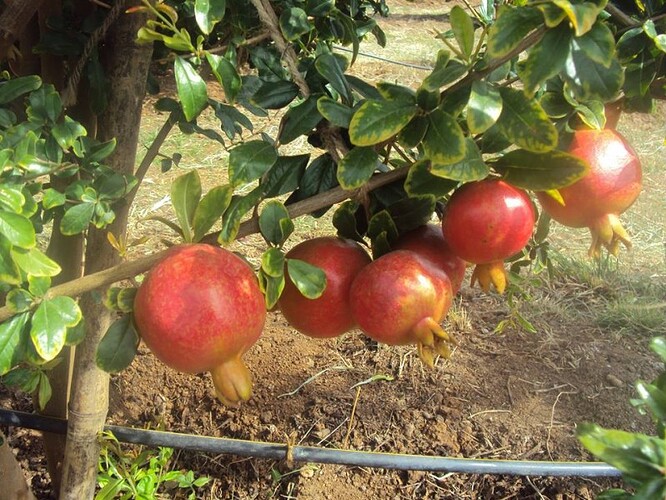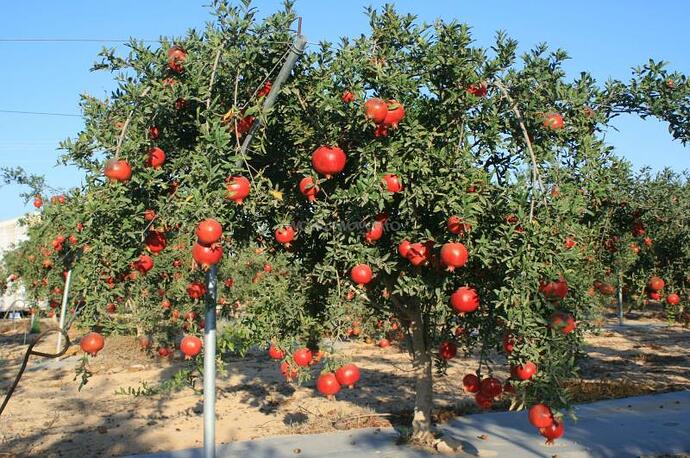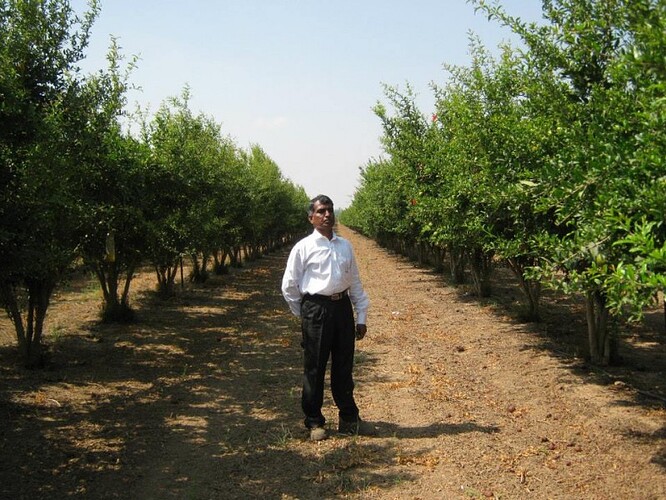Pomegranate is a fruit of paradise and a man who dies without tasting pomegranate in his life is really poor and unfortunate
Hi tech pomegranate cultivation has highest potential to yield about 15-18 MT of fruits per acre
Export potential for Indian Pomegranate –
West = Belgium, France & Holland
Center = Austria, Germany & Switzerland
South = Italy & Spain
North = Denmark, Finland & Sweden
Middle east – Arab countries and Singapore
Pomegranate is a dry land crop growing well in the temperature range of 15 degree Celsius to 40 degree Celsius .However it can survive in an extreme temperature of 0 degree Celsius in lower side and 48 degree Celsius on higher side . Pomegranate produce profuse flowering and big yield in sunny and dry climate …Humid climate with excess rain for prolonged period will damage the growth and yield of fruits in pomegranate …
India is having lot of cultivable waste land lying in semi arid and arid tract receiving annual average rainfall of 450 mms to 800 mm . Farmers in this tract of semi arid land can cultivate pomegranate and make reasonable money with minimum risk .
Farmers can make an arrangement in rainwater harvesting and store, use harvested rain water in summer for enhanced growth and yield and quality fruits
Water management is effectively followed and soil moisture is conserved with effective application of mulching either plastic or organic mulch
Soil quality – Pomegranate can be grown in wide range of soil with PH ranging between 6.0 to 8.0 . A deep loam or alluvial soil with good drainage facility and rich organic matter is best suited however in modern world of advanced agricultural technology . all those soil which are unfit for cultivation of other crops can be effectively managed to grow pomegranate
Planting season - Since plants need water for its establishment those farmers who are owing land in semi arid tract should take up planting during rainy season and those farmer who have land in assured irrigation tract can take up planting once after monsoon rain recedes .
Soil preparation – land is ploughed well and pit is dug out @ 2 feet LBD dimension and 3 feet dimension is preferred n area of heavy soil or rocky terrain to ensure drainage . Because the flooding in pomegranate field will damage new active white roots and hamper growth and yield
The white roots of pomegranate is the modification and adaptation of pomegranate as survival mechanism in semi arid tract . Any excess rain and flooding will damage this roots and it hinders the growth and plants just remains unproductive or poor yield and quality .
So the farmers whose land is subject to flooding during monsoon should make long beds of 3 feet wide and 2 feet high to provide for drainage and facilitate active growth of white roots
Planting medium to be placed inside the pit - each pit is filled up with 20 kgs of farmyard manure + 200-250 grams super phosphate + 0.50 kg neem cake and 0.50 kg groundnut cake
After planting seedlings active biological culture ( 1000 kgs of well decomposed farmyard manure is mixed with 1.0 each Azospirrillum and phosphobacteria , 1 .0 kg Trichoderma viride and 50 kgs of VAM fungal culture and incubated in moist condition with wet gunny bags covering the heap of this bio active culture . This culture is prepared a week or 10 days before planting and after seedlings are planted , 1.0 or 2.0 kgs are applied around the seedlings . This bio active culture multiply fast in the soil around the roots of pomegranate and induce the fast and active growth of roots and also protect the plant from soil borne disease .
Spacing of pomegranate – ( 410 plants per acre ) 3. 6 meter row to row spacing and 2.7 M plant to plant spacing is the best spacing for producing optimum yield of quality fruits . The wide spacing between row to row provide more air circulation , sun light penetration and free from insect pest and disease
Irrigation method – drip irrigation is the best method with emitters discharge capacity of 4 lit per hour and delivery of 20- 30 lit water per tree in accordance to prevailing weather condition .
Application of fertilizers (kg / plant)
Manures andFertilizers 1st year(kg) 2nd to 5th year (kg) 6th year onwards (kg)
FYM 20.00 25.0 30 .0
N 0.20 0.40 0.60
P 0.10 0.25 0.50
K 0.40 0.80 1.20
TRAINING AND PRUNING
Single stem is allowed up to 2.0 2.5 feet high and 3-4 scaffold or side branches are allowed on each main stem . since fruits are borne terminally on shoots emerging from mature wood . SO every year after harvest in December 1/3 of old and unproductive shoots are removed to induce productive shoots .
Flower induction
1.Through water stress – After pruning irrigation is withhold for 25 to 40 days depending on the prevailing condition . After this stress period , give water gradually increasing the quantity of water per tree according to the condition
2.Chemically induced stress – prune the trees and withhold water . In about 25- 40 days , ethephon @ 2.5 ml per lit water is prayed and irrigation is started and increased gradually to the rated delivery to each tree
According to the location of field in various climatic zone the water stress is induced variously in different months and leaves are shed down to the tune of 70- 100 % according to the season and method of stress induction
Fruiting and yield – The flowers are converted into matured fruits in about 5 – 6 months after flowering and there are 2 – 3 harvest made in a year based on the suitability of location for pomegranate cultivation
Regulation of bearing Pomegranate plants flower and provide fruits throughout the year in central and southern India. Depending on patterns of precipitation, flowering can be induced during June-July (mrig bahar), September-Octobber (hasta bahar) and January-February (ambe bahar). In areas having assured rainfall where precipitation is normally received in June and continues upto September, flowering in June is advantageous; where monsoon normally starts in August, flowering during August is beneficial. Areas having assured irrigation potential during April-May, flowering during January can be taken and where monsoon starts early and withdraws by September induction of flowering in October is possible. Considering comparable yields, prices and irrigation needs it is recommended that October cropping could be substituted for January flowering
Yield – Each tree can produce around 10-12 kgs of pomegranate fruits each weighing 250-400 grams . In order to produce quality fruits for overseas market , excess fruits must be removed to fix optimum load per tree
So @ 10-12 kgs of fruits per tree , an acre of pomegranate can produce 4100 to 5000 kgs
When the pomegranate attains 7-8 years , the yielding potential increase by three times say 15-18 MT per acre
Hello Ramu Sir,
I am planning for Pomegranate this June going for super bhagwa variety in 7 acres please refer me to the best planting suppliers you may know. met few farmers and reading forums is a bit scaring that pomegranate is very risky crop but i am ready to take the risk. I thank you in advance for the advise and information you provide my best wishes to you and best of hardwork with little bit of luck to me.
Best Regards,
Sriram.
Great …Bhagwa is an export variety of pomegranate with big arils and red or safron red rinds and individual fruit weight of 200-400 grams
Nothing to worry about risk in pomegranate production …success in pomegranate farming relies on selection of healthy true to type saplings , pest and disease management , soil with free drainage and periodical pruning of suckers etc …
I think you can have quality pomegranate seedlings from pune in maharastra



